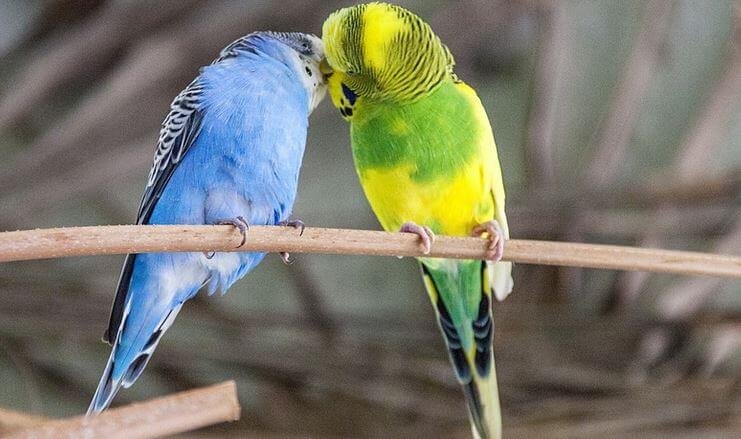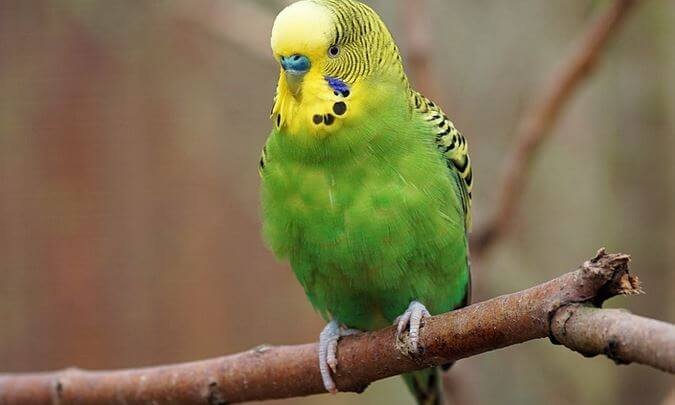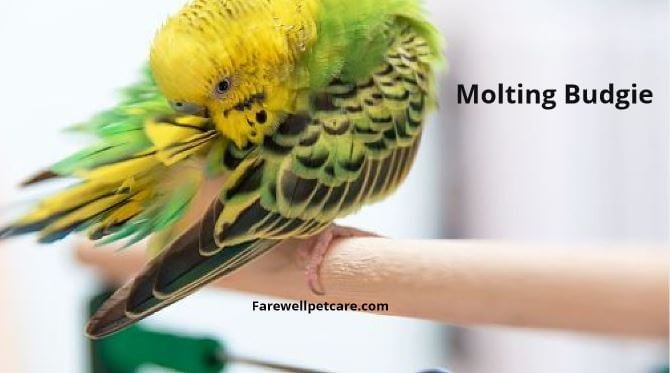Whether feather molt in your budgie bird results from environmental changes or just for a fresh new look, budgies give up their old coat at least once a year. So, specifically, when do budgies molt their feathers?
As a whole, there are no specific times for budgie molting. A budgie in a natural ecosystem can molt in spring, fall, or both seasons. In a home environment, budgies may molt at any time due to continued exposure to constant temperature and artificial light.
Budgies molt their feathers at first when they are 3-4 months of age. This is referred to as juvenile molt. From the first molt, they will continue to undergo molting in their lifetime one or two times a year. Let’s learn more right next.
When Do Budgies Molt Their Feathers?

Molting is a natural process in birds that involves gradual feather shedding and replacement with new, fresh feathers. It’s a strenuous process that causes discomfort while it occurs. So, your budgie may develop a bad temperament when molting.
Wild birds, including budgies, begin molting, migrating, and breeding as the seasons and daylight hours change. So, molting is a serious business in the birds’ kingdom in the spring and fall.
That may not be the case for domesticated budgies as they are continuously exposed to artificial light sources, a proper diet, and constant room temperatures. These budgies can molt at any time of the year as long as the internal clock ticks in a favorable environment.
Remember, home environment conditions do not mimic what real nature provides in the wild. So don’t expect a regular molting pattern for your caged budgies. If you see your budgie taking long molting or having short molt cycles, it’s probably due to the varied domestic conditions.
So that the bird is not stripped naked and rendered unable to fly, feather loss occurs slowly and systematically. It follows a sequence that allows the bird to perform the essential functions of flying.
The feather molt process could run for 2-3 weeks under normal conditions. However, it’s not uncommon for some budgies to molt for several months.
Also Read: Why Is My Budgie Panting? 6 Main Reasons
What Age Do Budgies Start Molting?
When you are an inexperienced budgie owner, you don’t know much about molting and whether your little budgie should already be going through the process.
As a general rule of thumb, budgies start to molt at 3-4 months of age. This is called juvenile molt, the first molt of your small baby budgie.
Juvenile molt involves a soft molt that leaves a mix of old and new feathers on a young bird’s coat. Usually, this results in an awkward, patchy coat appearance.
Juveniles start losing feathers the moment their parents leave them on their own. They may have different color patterns on their bodies compared to their mothers.
And that’s due to the slow molt process that leaves the bird with old feathers mixing with new feathers–creating a strange plumage altogether.
Budgie Molting Symptoms
A molting budgie can go through serious discomfort. It’s important to know when your budgie is molting to help it when needed. Here are the crucial budgie molting symptoms to look for:
- Several Loose Feathers Scattered On The Floor.
This results from self-scratching and plucking to cool down the itchiness accompanying molting. Be careful, as too much feather loss could indicate a serious underlying problem.
- Lethargy And Overall Tiredness
One sign that shows your bird is molting is general tiredness. You can observe this behavior by looking at sleeping patterns. A molting bird requires plenty of energy for the molting process to work and finish in time.
Ultimately, the process drains your bird’s energy reserves, leaving it feeble. Rest or sleep is the best way to recover from such lethargy and tiredness.
- Loss Of Appetite
Generally, your budgie may lose interest in food. Remember that birds in this life cycle need proper nutrition to meet their high-energy needs.
You will see a drop in the amount of food your bird eats. But note that this appetite loss is relative from one bird to another.
- Aggressive Behavior, Such As Biting
Due to ongoing feather loss, an irritated bird may show an aggressive temperament. The bird may bite you if you get your hand closer to the cage.
That’s simply a way of communicating the much pain getting under its nerves. So, you need to be careful sticking your finger in the cage.
- The appearance of Spiky Regrowth
Spike-like regrowth is common during feather molt in birds. These are the roots from where new feathers will sprout.
These points are alive and contain blood and sensitive nerve endings. When touched indiscriminately, they could transmit great pain to the rest of the body, making your budgie uncomfortable.
- Preening
A molting budgie engages in a lot of preening activities. It keeps on grooming and repositioning tail feathers.
What to Feed a Molting Budgie

Feeding is a crucial aspect that influences feather molt in birds. In fact, the availability of food necessitates molting in natural ecosystems.
With that in mind, domesticated budgies also need proper feeding and nutrition to ensure a smooth, uninterrupted process.
When feeding a molting budgie, ensure balanced proportions of carbohydrates, proteins, fat, vitamins, minerals, and water. You can provide pelleted bird food formulation as it supplies your bird’s nutritional needs.
According to nutritional experts, the pelleted formulation is the best diet for your molting bird. But it takes plenty of effort to condition a seed-eating budgie from its routine to feeding on pellets.
A high-protein and fat diet is particularly recommended for molting birds. These food ensure high-quality feather growth. Do you know that 90% of the feather composition is proteins known as keratin?
So make sure your bird’s feeders contain a blend of peanuts, Nyjer (thistle), bark butter, and mealworms. Also, provide boiled eggs, sprouted grains, and fresh veggies.
Supply vitamins in sufficient quantities. Provide fresh produce rich in Vitamin A, such as:
- Collards
- Carrot
- Spinach
- Swiss chard
- Turnip greens
- Cucumber
To ensure your bird’s metabolic activities are well catered to, its diet should feature Vitamin B foods like broccoli, bananas, legumes, sweet potatoes, and more.
When providing fruits and vegetables, you want to limit them to not more than 20-25% of the daily diet. Don’t provide toxic fruits like avocado, as they may affect your bird’s health.
Why Is My Budgie Molting Frequently?
While molting is a natural self-driven process in birds, many questions arise when molting occurs frequently. This is a cause for alarm, even for experienced budgie owners.
Some of the reasons that could induce frequent and abnormal molting in budgies include malnutrition, poor insulation, French molt due to a weakened immune system, and ectoparasites. Improper molting can only worsen your bird’s anxious state.
Let’s look at why a budgie could experience frequent molts.
Poor Nutrition
Usually, a proper diet helps to keep your bird in the best shape possible during molting. You should ensure that the food plan supplies nutrients in the required proportions.
Overfeeding your budgie on seed mixes is a bad practice. Neither is feeding the bird too many fruits and vegetables. The perfect diet balance should supply all nutrients a budgie requires; lack or too much of any can cause malnutrition.
Poor Insulation
Your budgie pet will likely get stressed if the surrounding environment is predominately cold. Temperature dips can worsen molting.
The recommended temperature level for the bird is above 70℉ (21.11℃). This keeps your bird warm and well-insulated.
Ectoparasites
Parasites that infest your bird’s skin can also trigger frequent soft molts. Generally, a budgie affected with parasites is often unsettled and agitated.
For example, the Giardia parasite is a nuisance for many birds, including budgies. Once the parasite reaches the skin of a budgie, it pricks and makes an itching sensation.
To eliminate the irritation, your budgie resorts to over-grooming by plucking its feathers. It’s not strange for the budgies to scream for help when the irritation goes overboard.
French Molt
French molt is a disease that mainly infects young budgies. Its other name is budgerigar fledgling disease.
A sudden and excessive loss of feathers characterizes the disease. This happens when a budgie is about six weeks of age. The disease renders the budgie completely flightless.
Usually, French Molt affects wing and tail feathers. Caused by a virus called Avian polyomavirus, French Molt can have severe effects on the molting cycle of birds. If your bird has this virus, it will likely be molting over a long period.
In the early stages of the French Molt disease, inexperienced budgie owners may confuse symptoms with the normal feather molt. Here is a quick table showing the differences between the two conditions.
| French Molt | Normal Feather Molt |
| Primary feathers around wings and tail drop | Uniform feather loss |
| Sudden and rapid feather loss | Gradual dropping of feathers |
| Dried blood spots from areas where feathers fell | No blood seen around feather root spots |
| A patchy coat | You cannot see patches on the coat |
| Diarrhea | No diarrhea |
| Swelling in the abdomen | No swelling in the abdomen |
French Molt is a severe budgie disease. Make sure you visit the veterinarian immediately when you notice symptoms.
Final Thoughts
Understanding when budgies molt their feathers is an essential aspect of responsible budgie care.
Molting is a natural process that can be stressful for budgies, but with the right care and attention, you can help your feathered friend navigate this phase easily.
By observing your budgie’s behavior and providing them with a healthy diet, plenty of water, and a stress-free environment, you can help ensure their molt goes smoothly.

